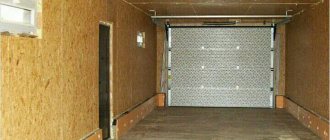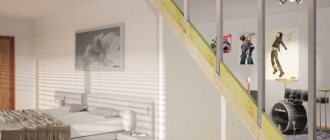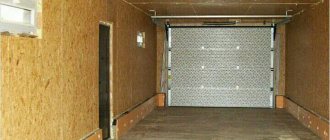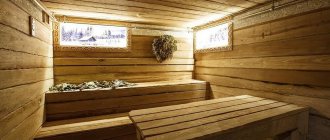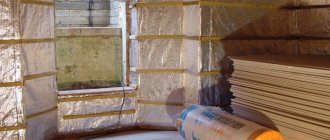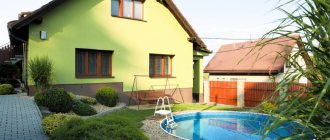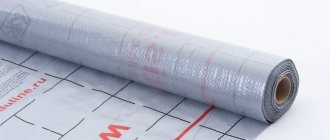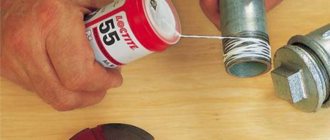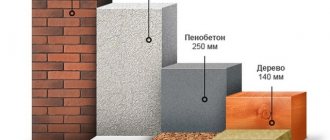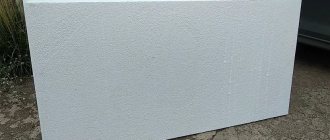Table of thermal conductivity of thermal insulation materials
To make it easier to keep your house warm in winter and cool in summer, the thermal conductivity of walls, floors and roofs must be at least a certain figure, which is calculated for each region.
The composition of the “pie” of walls, floor and ceiling, the thickness of the materials are taken into account so that the total figure is no less (or better yet, at least a little more) recommended for your region. Heat transfer coefficient of modern building materials for enclosing structures
When choosing materials, it is necessary to take into account that some of them (not all) conduct heat much better in conditions of high humidity. If such a situation may occur for a long period of time during operation, the thermal conductivity for this condition is used in the calculations. The thermal conductivity coefficients of the main materials used for insulation are given in the table.
| Name of material | Thermal conductivity coefficient W/(m °C) | ||
| Dry | At normal humidity | At high humidity | |
| Woolen felt | 0,036-0,041 | 0,038-0,044 | 0,044-0,050 |
| Stone mineral wool 25-50 kg/m3 | 0,036 | 0,042 | 0,,045 |
| Stone mineral wool 40-60 kg/m3 | 0,035 | 0,041 | 0,044 |
| Stone mineral wool 80-125 kg/m3 | 0,036 | 0,042 | 0,045 |
| Stone mineral wool 140-175 kg/m3 | 0,037 | 0,043 | 0,0456 |
| Stone mineral wool 180 kg/m3 | 0,038 | 0,045 | 0,048 |
| Glass wool 15 kg/m3 | 0,046 | 0,049 | 0,055 |
| Glass wool 17 kg/m3 | 0,044 | 0,047 | 0,053 |
| Glass wool 20 kg/m3 | 0,04 | 0,043 | 0,048 |
| Glass wool 30 kg/m3 | 0,04 | 0,042 | 0,046 |
| Glass wool 35 kg/m3 | 0,039 | 0,041 | 0,046 |
| Glass wool 45 kg/m3 | 0,039 | 0,041 | 0,045 |
| Glass wool 60 kg/m3 | 0,038 | 0,040 | 0,045 |
| Glass wool 75 kg/m3 | 0,04 | 0,042 | 0,047 |
| Glass wool 85 kg/m3 | 0,044 | 0,046 | 0,050 |
| Expanded polystyrene (foam plastic, EPS) | 0,036-0,041 | 0,038-0,044 | 0,044-0,050 |
| Extruded polystyrene foam (EPS, XPS) | 0,029 | 0,030 | 0,031 |
| Foam concrete, aerated concrete with cement mortar, 600 kg/m3 | 0,14 | 0,22 | 0,26 |
| Foam concrete, aerated concrete with cement mortar, 400 kg/m3 | 0,11 | 0,14 | 0,15 |
| Foam concrete, aerated concrete with lime mortar, 600 kg/m3 | 0,15 | 0,28 | 0,34 |
| Foam concrete, aerated concrete with lime mortar, 400 kg/m3 | 0,13 | 0,22 | 0,28 |
| Foam glass, crumbs, 100 - 150 kg/m3 | 0,043-0,06 | ||
| Foam glass, crumbs, 151 - 200 kg/m3 | 0,06-0,063 | ||
| Foam glass, crumbs, 201 - 250 kg/m3 | 0,066-0,073 | ||
| Foam glass, crumbs, 251 - 400 kg/m3 | 0,085-0,1 | ||
| Foam block 100 - 120 kg/m3 | 0,043-0,045 | ||
| Foam block 121-170 kg/m3 | 0,05-0,062 | ||
| Foam block 171 - 220 kg/m3 | 0,057-0,063 | ||
| Foam block 221 - 270 kg/m3 | 0,073 | ||
| Ecowool | 0,037-0,042 | ||
| Polyurethane foam (PPU) 40 kg/m3 | 0,029 | 0,031 | 0,05 |
| Polyurethane foam (PPU) 60 kg/m3 | 0,035 | 0,036 | 0,041 |
| Polyurethane foam (PPU) 80 kg/m3 | 0,041 | 0,042 | 0,04 |
| Cross-linked polyethylene foam | 0,031-0,038 | ||
| Vacuum | |||
| Air +27°C. 1 atm | 0,026 | ||
| Xenon | 0,0057 | ||
| Argon | 0,0177 | ||
| Airgel (Aspen aerogels) | 0,014-0,021 | ||
| Slag | 0,05 | ||
| Vermiculite | 0,064-0,074 | ||
| Foam rubber | 0,033 | ||
| Cork sheets 220 kg/m3 | 0,035 | ||
| Cork sheets 260 kg/m3 | 0,05 | ||
| Basalt mats, canvases | 0,03-0,04 | ||
| Tow | 0,05 | ||
| Perlite, 200 kg/m3 | 0,05 | ||
| Expanded perlite, 100 kg/m3 | 0,06 | ||
| Linen insulating boards, 250 kg/m3 | 0,054 | ||
| Polystyrene concrete, 150-500 kg/m3 | 0,052-0,145 | ||
| Granulated cork, 45 kg/m3 | 0,038 | ||
| Mineral cork on a bitumen basis, 270-350 kg/m3 | 0,076-0,096 | ||
| Cork flooring, 540 kg/m3 | 0,078 | ||
| Technical cork, 50 kg/m3 | 0,037 |
Some of the information is taken from standards that prescribe the characteristics of certain materials (SNiP 23-02-2003, SP 50.13330.2012, SNiP II-3-79* (Appendix 2)). Those materials that are not specified in the standards are found on the manufacturers’ websites
Since there are no standards, they can differ significantly from different manufacturers, so when purchasing, pay attention to the characteristics of each material purchased
What you need to know about the thermal conductivity of foam plastic
The ability of a material to transfer heat, conduct or retain heat flows is usually assessed by the thermal conductivity coefficient. If you look at its dimension - W/m∙C o , it becomes clear that this is a specific value, that is, determined for the following conditions:
- The absence of moisture on the surface of the slab, that is, the thermal conductivity coefficient of polystyrene foam from the reference book, is a value determined in ideally dry conditions, which practically do not exist in nature, except perhaps in the desert or Antarctica;
- The value of the thermal conductivity coefficient is given for a foam thickness of 1 meter, which is very convenient for theory, but somehow not impressive for practical calculations;
- The results of measuring thermal conductivity and heat transfer were carried out for normal conditions at a temperature of 20 o C.
According to a simplified method, when calculating the thermal resistance of a layer of foam insulation, you need to multiply the thickness of the material by the thermal conductivity coefficient, then multiply or divide by several coefficients used to take into account the actual operating conditions of the thermal insulation. For example, strong watering of the material, or the presence of cold bridges, or the method of installation on the walls of the building.
How the thermal conductivity of polystyrene foam differs from other materials can be seen in the comparison table below.
It's actually not that simple. To determine the thermal conductivity value, you can create it yourself or use a ready-made program for calculating insulation parameters. For a small object this is usually done. A private owner or self-builder may not be interested in the thermal conductivity of the walls at all, but rather lay insulation from foam plastic material with a margin of 50 mm, which will be quite enough for the harshest winters.
Large construction companies that insulate walls covering an area of tens of thousands of square meters prefer to act more pragmatically. The calculation of the insulation thickness is used to draw up an estimate, and the actual thermal conductivity values are obtained on a full-scale object. To do this, glue several sheets of foam plastic of different thicknesses onto a section of the wall and measure the actual thermal resistance of the insulation. As a result, it is possible to calculate the optimal thickness of the foam with an accuracy of several millimeters; instead of approximately 100 mm of insulation, you can lay the exact value of 80 mm and save a considerable amount of money.
How beneficial the use of polystyrene foam is in comparison with standard materials can be assessed from the diagram below.
Valid values
When performing a thermal engineering calculation of an external wall, the region in which the house will be located is also taken into account:
- For southern regions with warm winters and slight temperature changes, walls of small thickness can be erected from materials with an average degree of thermal conductivity - single and double fired ceramic and clay, brick, high-density foam and aerated concrete. The wall thickness for such regions can be no more than 20 cm.
- At the same time, for the northern regions it is more expedient and economically profitable to build enclosing wall structures of medium and large thickness from materials with high thermal resistance - rounded logs, gas- and foam concrete of medium density. For such conditions, wall structures up to 50–60 cm thick are erected.
- For regions with a temperate climate and winters alternating in temperature, walls made of materials with high and medium thermal resistance are suitable - gas and foam concrete, timber, rounded logs of medium diameter. In such conditions, the thickness of the wall enclosing structures, taking into account insulation, is no more than 40–45 cm.
How to calculate wall thickness
In order for the house to be warm in winter and cool in summer, it is necessary that the enclosing structures (walls, floor, ceiling/roof) must have a certain thermal resistance. This value is different for each region. It depends on the average temperatures and humidity in a particular area.
Thermal resistance of enclosing structures for regions of Russia
In order for heating bills not to be too high, it is necessary to select building materials and their thickness so that their total thermal resistance is not less than that indicated in the table.
Calculation of wall thickness, insulation thickness, finishing layers
Modern construction is characterized by a situation where the wall has several layers. In addition to the supporting structure, there is insulation and finishing materials. Each layer has its own thickness. How to determine the thickness of insulation? The calculation is simple. Based on the formula:
Formula for calculating thermal resistance
R—thermal resistance;
p—layer thickness in meters;
k is the thermal conductivity coefficient.
First you need to decide on the materials that you will use during construction. Moreover, you need to know exactly what type of wall material, insulation, finishing, etc. will be. After all, each of them makes its contribution to thermal insulation, and the thermal conductivity of building materials is taken into account in the calculation.
First, the thermal resistance of the structural material (from which the wall, ceiling, etc. will be built) is calculated, then the thickness of the selected insulation is selected based on the “residual” principle. You can also take into account the thermal insulation characteristics of finishing materials, but usually they are a plus to the main ones. This is how a certain reserve is laid down “just in case.” This reserve allows you to save on heating, which subsequently has a positive effect on the budget.
An example of calculating the thickness of insulation
Let's look at it with an example. We are going to build a brick wall - one and a half bricks long, and we will insulate it with mineral wool. According to the table, the thermal resistance of walls for the region should be at least 3.5. The calculation for this situation is given below.
- First, let's calculate the thermal resistance of a brick wall. One and a half bricks is 38 cm or 0.38 meters, the thermal conductivity coefficient of brickwork is 0.56. We calculate using the above formula: 0.38/0.56 = 0.68. A wall of 1.5 bricks has this thermal resistance.
- We subtract this value from the total thermal resistance for the region: 3.5-0.68 = 2.82.
This value must be “added” with thermal insulation and finishing materials. All enclosing structures will have to be calculated - We calculate the thickness of mineral wool. Its thermal conductivity coefficient is 0.045. The thickness of the layer will be: 2.82 * 0.045 = 0.1269 m or 12.7 cm. That is, to ensure the required level of insulation, the thickness of the mineral wool layer must be at least 13 cm.
If the budget is limited, you can take 10 cm of mineral wool, and the missing amount will be covered with finishing materials. They will be inside and outside. But, if you want your heating bills to be minimal, it is better to use the finishing as a “plus” to the calculated value. This is your reserve during the lowest temperatures, since thermal resistance standards for enclosing structures are calculated based on the average temperature over several years, and winters can be abnormally cold
Therefore, the thermal conductivity of building materials used for finishing is simply not taken into account
Ideal warm home
The comfort and economy of living in it depends on the design features of the building and the materials used in its construction. Comfort lies in creating an optimal microclimate inside, regardless of external weather conditions and ambient temperature. If the materials are selected correctly, and the boiler equipment and ventilation are installed according to the standards, then such a house will have a comfortable, cool temperature in summer and warmth in winter. In addition, if all materials used in construction have good thermal insulation properties, then energy costs for space heating will be minimal.
Table of thermal conductivity of materials on Pa-Pen
| Material | Density, kg/m3 | Thermal conductivity, W/(m deg) | Heat capacity, J/(kg deg) |
| Tow | 150 | 0.05 | 2300 |
| Gypsum wall panels DIN 1863 | 600…900 | 0.29…0.41 | — |
| Paraffin | 870…920 | 0.27 | — |
| Oak parquet | 1800 | 0.42 | 1100 |
| Piece parquet | 1150 | 0.23 | 880 |
| Panel parquet | 700 | 0.17 | 880 |
| Pumice | 400…700 | 0.11…0.16 | — |
| Pumice concrete | 800…1600 | 0.19…0.52 | 840 |
| Foam concrete | 300…1250 | 0.12…0.35 | 840 |
| Foam gypsum | 300…600 | 0.1…0.15 | — |
| Foam ash concrete | 800…1200 | 0.17…0.29 | — |
| Polystyrene foam PS-1 | 100 | 0.037 | — |
| Polyfoam PS-4 | 70 | 0.04 | — |
| Foam plastic PVC-1 (TU 6-05-1179-75) and PV-1 (TU 6-05-1158-78) | 65…125 | 0.031…0.052 | 1260 |
| Foam resopen FRP-1 | 65…110 | 0.041…0.043 | — |
| Expanded polystyrene (GOST 15588-70) | 40 | 0.038 | 1340 |
| Expanded polystyrene (TU 6-05-11-78-78) | 100…150 | 0.041…0.05 | 1340 |
| Expanded polystyrene "Penoplex" | 35…43 | 0.028…0.03 | 1600 |
| Polyurethane foam (TU V-56-70, TU 67-98-75, TU 67-87-75) | 40…80 | 0.029…0.041 | 1470 |
| Polyurethane foam sheets | 150 | 0.035…0.04 | — |
| Polyethylene foam | — | 0.035…0.05 | — |
| Polyurethane foam panels | — | 0.025 | — |
| Penosilalcite | 400…1200 | 0.122…0.32 | — |
| Lightweight foam glass | 100..200 | 0.045…0.07 | — |
| Foam glass or gas glass (TU 21-BSSR-86-73) | 200…400 | 0.07…0.11 | 840 |
| Penofol | 44…74 | 0.037…0.039 | — |
Main characteristics of insulation
Let us first provide the characteristics of the most popular thermal insulation materials, which you should first pay attention to when choosing. Comparison of thermal conductivity insulation should be made only on the basis of the purpose of the materials and room conditions (humidity, presence of open fire, etc.). We have further arranged in order of importance the main characteristics of insulation
We have further arranged in order of importance the main characteristics of insulation.
Comparison of building materials
Thermal conductivity. The lower this indicator, the less thermal insulation layer is required, which means that insulation costs will also be reduced.
Moisture permeability. The lower permeability of the material to moisture vapor reduces the negative impact on the insulation during operation.
Fire safety. Thermal insulation should not burn or emit toxic gases, especially when insulating a boiler room or chimney.
Durability. The longer the service life, the cheaper it will cost you during operation, since it will not require frequent replacement.
Environmentally friendly. The material must be safe for humans and the environment.
Installation of various types
- expanded clay It is used exclusively for floors and interfloor ceilings. You need an entrenching tool and additional building materials (screed or boards). You will also need a waterproofing layer in the form of roofing felt or other similar material.
- mineral wool. Proper installation involves using hand tools to secure the frame. Mineral wool is very easily installed in pre-prepared cells, but uniform fastening is required over the entire plane. A waterproofing layer on top of the insulation is a prerequisite for long-term operation. Can be used for vertical and horizontal surfaces.
Please note: when installing any type of insulation, it is important to remember about hydro- and vapor barrier. It is very important to protect the finish from direct exposure to moisture.
- Styrofoam. The slabs are attached to the surface with dowels with “nickels”. The necessary tools include a screwdriver, a hammer drill, a construction knife and dowels. The shape of the building material and light weight even allows you to independently complete the entire volume of work in a short period of time.
- foam glass. For a tight connection with the surface, mechanical fasteners or solutions (cement, mastics and other adhesives) are used. The choice depends on the wall material. Blocks are very popular, but slabs and granules are also available.
Table of thermal conductivity of materials on Cl...
| Material | Density, kg/m3 | Thermal conductivity, W/(m deg) | Heat capacity, J/(kg deg) |
| Rubble masonry made of medium-density stones | 2000 | 1.35 | 880 |
| Gas silicate masonry | 630…820 | 0.26…0.34 | 880 |
| Masonry made of gas silicate thermal insulation boards | 540 | 0.24 | 880 |
| Masonry of ordinary clay bricks on cement-perlite mortar | 1600 | 0.47 | 880 |
| Masonry of ordinary clay bricks (GOST 530-80) on cement-sand mortar | 1800 | 0.56 | 880 |
| Masonry of ordinary clay bricks on cement-slag mortar | 1700 | 0.52 | 880 |
| Masonry of ceramic hollow bricks with cement-sand mortar | 1000…1400 | 0.35…0.47 | 880 |
| Small brick masonry | 1730 | 0.8 | 880 |
| Masonry made of hollow wall blocks | 1220…1460 | 0.5…0.65 | 880 |
| Masonry made of 11-hollow silicate bricks with cement-sand mortar | 1500 | 0.64 | 880 |
| Masonry made of 14-hollow silicate bricks with cement-sand mortar | 1400 | 0.52 | 880 |
| Sand-lime brick masonry (GOST 379-79) with cement-sand mortar | 1800 | 0.7 | 880 |
| Triple brick masonry (GOST 648-73) with cement-sand mortar | 1000…1200 | 0.29…0.35 | 880 |
| Cellular brick masonry | 1300 | 0.5 | 880 |
| Slag brick masonry with cement-sand mortar | 1500 | 0.52 | 880 |
| Masonry "Poroton" | 800 | 0.31 | 900 |
| Maple | 620…750 | 0.19 | — |
| Leather | 800…1000 | 0.14…0.16 | — |
| Technical composites | — | 0.3…2 | — |
| Oil paint (enamel) | 1030…2045 | 0.18…0.4 | 650…2000 |
| Silicon | 2000…2330 | 148 | 714 |
| Organosilicon polymer KM-9 | 1160 | 0.2 | 1150 |
MONOLITHIC PLATE FOUNDATION (USF) extruded polystyrene foam (EPS) and foam glass crushed stone
Classic slab foundation using EPS
Construction of a slab foundation using foam glass crushed stone
| № | Name of works | UNITS change | Without foam glass | With fractionated foam glass 40 cm (28 compacted) | With fractionated foam glass 32 cm (25 compacted) | ||||||
| quantity | price | sum | quantity | price | sum | quantity | price | sum | |||
| 1 | Excavation work (without soil removal) | m3 | 79 | 500 | 39 500 | 45 | 500 | 22 500 | 45 | 500 | 22 500 |
| 2 | Geotextile grade 300 | m2 | 280 | 60 | 16 800 | 280 | 60 | 16 800 | 280 | 60 | 16 800 |
| 3 | Sandy base, with work | m3 | 27 | 800 | 21600 | ||||||
| 4 | Crushed stone base and drainage, with work | m3 | 45 | 2 050 | 92 250 | ||||||
| 5 | Waterproofing: PVC film 200 microns, with work | m2 | 280 | 45 | 12 600 | ||||||
| 6 | Waterproofing: profiled membrane, with work | m2 | 280 | 115 | 32 200 | 280 | 115 | 32 200 | |||
| 7 | EPPS 80 mm in 2 layers of sub-slabs and 1 layer for the blind area | m3 | 29 | 4800 | 139200 | ||||||
| 8 | Work on EPPS | m3 | 29 | 450 | 13 050 | ||||||
| 9 | Fractionated foam glass, with a blind area of 200 mm | m3 | 71 | 3000 | 213 000 | 59 | 3000 | 177 000 | |||
| 10 | Work on fractionated foam glass | m3 | 71 | 350 | 24 850 | 59 | 350 | 20 650 | |||
| 11 | Construction of a reinforced monolithic slab 12x12x0.25 m | m3 | 36 | 8 500 | 306 000 | 36 | 8 500 | 306 000 | 36 | 8 500 | 306 000 |
| TOTAL, rub.: | 641 000 | 615 350 | 575150 | ||||||||
| SAVINGS, rub.: | 25 650 | 65 850 | |||||||||
| Saving, % | 4,10 % | 10,30 % | |||||||||
Thermal conductivity coefficient of building materials - tables
The thermal insulation properties of materials are perfectly demonstrated by summary tables that present standard indicators.
Table of heat transfer coefficients of materials. Part 1
Heat conductivity of materials. Part 2 Table of thermal conductivity of insulating materials for concrete floors
But these tables of thermal conductivity of materials and insulation materials do not take into account all the values. Let's take a closer look at the heat transfer of basic building materials.
Brick thermal conductivity table
As we have already seen, brick is not the “warmest” wall material. In terms of thermal efficiency, it lags behind wood, foam concrete and expanded clay. But with proper insulation, it makes for cozy and warm homes.
Comparison of thermal conductivity of building materials by thickness (brick and foam concrete)
But not all types of brick have the same thermal conductivity coefficient (λ). For example, for clinker it is the largest - 0.4−0.9 W/(m K). Therefore, it is impractical to build something out of it. Most often it is used for road work and laying floors in technical buildings. The smallest coefficient of this characteristic is for the so-called thermal ceramics - only 0.11 W/(m K). But such a product is also very fragile, which minimizes its scope of application.
A good match between strength and thermal efficiency of sand-lime bricks. But masonry made from them also needs additional insulation, and depending on the region of construction, perhaps also thickening the wall. Below is a comparative table of heat conductivity values for different types of bricks.
Thermal conductivity of different types of bricks
Table of thermal conductivity of metals
The thermal conductivity of metals is no less important in construction, for example, when choosing heating radiators. Also, such values cannot be avoided when welding critical structures, producing semiconductors and various insulators. Below are comparative tables of the thermal conductivity of various metals.
Thermal efficiency of different types of metals. Part 1 Thermal efficiency of different types of metals. Part 2 Thermal efficiency of different types of metals. Part 3
Wood thermal conductivity table
Wood in construction is unofficially classified as an elite material for building houses. And this is not only because of environmental friendliness and high cost. Wood has the lowest thermal conductivity coefficients. Moreover, such values directly depend on the breed. The lowest coefficient among building species is cedar (only 0.095 W/(m∙C)) and cork. Building houses from the latter is very expensive and problematic. But cork for flooring is valued because of its low heat conductivity and good sound insulation qualities. Below are tables of thermal conductivity and strength of various rocks.
Heat conductivity of woodStrength of different types of wood
Table of thermal conductivity of concrete
Concrete in its various variations is the most common building material today, although it is not the “warmest”. In construction, a distinction is made between structural and thermal insulating concrete. The former are used to build foundations and critical components of buildings with subsequent insulation, while the latter are used to build walls. Depending on the region, either additional insulation is applied to them or not.
Comparative table of thermal insulation concrete and thermal conductivity of various wall materials
Aerated concrete is considered the most “warm” and durable. Although this is not entirely true. If you compare the structure of foam blocks and aerated concrete, you can see significant differences. In the first, the pores are closed, while in gas silicates, most of them are open, as if “torn.” This is why in windy weather an uninsulated house made of aerated blocks is very cold. The same reason makes such lightweight concrete more susceptible to moisture.
What is the thermal conductivity coefficient of the air gap?
In construction, windproof air layers are often used, which only increase the heat conductivity of the entire building. Also, such vents are necessary to remove moisture outside.
Particular attention is paid to the design of such layers in foam concrete buildings for various purposes. Such layers also have their own thermal conductivity coefficient depending on their thickness
Table of heat conductivity of air layers
Results
What to build the warmest house from?
The warmest materials for building a house are considered to be brick, ceramic blocks, wood concrete, SIP panels and cellular concrete (aerated concrete, foam block, expanded clay block). Wooden and frame houses in cold climates need insulation.
We have also already discussed this issue in the article “What to build a house from in Siberia.”
What can you build a house from inexpensively and with high quality?
The following can compete for the title of the most profitable material for building a house:
- expanded clay blocks
- cinder blocks
- SIP panels
- frame construction
Which material is the most environmentally friendly?
The most environmentally friendly materials for building a house are:
- tree
- expanded clay block
- brick
- ceramic block
- frame houses
What can you quickly build a house from?
If you are interested in what material is the fastest to build a house from, then it is better to pay attention to the frame house construction technology. Houses are also quickly built from:
- SIP panels
- tree
- expanded clay blocks
- ceramic blocks
- cinder blocks
- wood concrete
Lightweight cellular concrete allows you to build a house quickly because... a powerful foundation is not needed, and masonry is easy and quick (the blocks are relatively light and large).
If individual construction is planned
When building a house, it is important to take into account the technical characteristics of all components (wall material, masonry mortar, future insulation, waterproofing and steam-removing films, finishing). To understand which walls will best retain heat, you need to analyze the thermal conductivity coefficient of not only the wall material, but also the mortar, as can be seen from the table below: To understand which walls will best retain heat, you need to analyze the thermal conductivity coefficient of not only the wall material, but also the mortar, as can be seen from the table below:
To understand which walls will best retain heat, you need to analyze the thermal conductivity coefficient of not only the wall material, but also the mortar, as can be seen from the table below:
| Order number | Wall material, mortar | Thermal conductivity coefficient according to SNiP |
| 1. | Brick | 0,35 – 0,87 |
| 2. | Adobe blocks | 0,1 – 0,44 |
| 3. | Concrete | 1,51 – 1,86 |
| 4. | Foam concrete and cement-based aerated concrete | 0,11 – 0,43 |
| 5. | Foam concrete and lime-based aerated concrete | 0,13 – 0,55 |
| 6. | Cellular concrete | 0,08 – 0,26 |
| 7. | Ceramic blocks | 0,14 – 0,18 |
| 8. | Cement-sand mortar | 0,58 – 0,93 |
| 9. | Mortar with added lime | 0,47 – 0,81 |
Important. From the data given in the table it can be seen that each building material has a fairly large spread in the thermal conductivity coefficient.
This is due to several reasons:
- Density. All insulation materials are produced or installed (penoizol, ecowool) of varying densities. The lower the density (more air is present in the insulating structure), the lower the heat conductivity. And, conversely, for very dense insulation materials this coefficient is higher.
- The substance from which it is produced (base). For example, brick can be silicate, ceramic, or clay. The thermal conductivity coefficient also depends on this.
- Number of voids. This applies to bricks (hollow and solid) and thermal insulation. Air is the worst conductor of heat. Its thermal conductivity coefficient is 0.026. The more voids, the lower this figure.
Mortar conducts heat well, so it is recommended to insulate any walls.
Sequencing
First of all, you need to choose the building materials that you will use to build the house. After this, we calculate the thermal resistance of the wall according to the scheme described above. The obtained values should be compared with the data in the tables. If they match or are higher, good.
If the value is lower than in the table, then you need to increase the thickness of the insulation or wall and perform the calculation again. If the structure contains an air gap that is ventilated with outside air, then the layers located between the air chamber and the street should not be taken into account.
Thermal conductivity of polystyrene foam from 50 mm to 150 mm is considered thermal insulation
Expanded polystyrene boards, colloquially referred to as polystyrene foam, are an insulating material, usually white. It is made from thermally expanded polystyrene. In appearance, the foam is presented in the form of small moisture-resistant granules; during the melting process at high temperatures, it is smelted into one whole, a slab. The sizes of the granule parts are considered to be from 5 to 15 mm. The outstanding thermal conductivity of 150 mm thick foam is achieved due to a unique structure - granules.
Each granule has a huge number of thin-walled micro-cells, which in turn increase the area of contact with air many times over. We can say with confidence that almost all polystyrene foam consists of atmospheric air, approximately 98%, in turn, this fact is their purpose - thermal insulation of buildings both outside and inside.
Everyone knows, even from physics courses, that atmospheric air is the main insulator of heat in all thermal insulation materials; it is in a normal and rarefied state, in the thickness of the material. Heat-saving, the main quality of polystyrene foam.
As mentioned earlier, polystyrene foam is almost 100% air, and this in turn determines the high ability of polystyrene foam to retain heat. This is due to the fact that air has the lowest thermal conductivity. If we look at the numbers, we will see that the thermal conductivity of polystyrene foam is expressed in the range of values from 0.037 W/mK to 0.043 W/mK. This can be compared with the thermal conductivity of air - 0.027 W/mK.
While the thermal conductivity of popular materials such as wood (0.12 W/mK), red brick (0.7 W/mK), expanded clay (0.12 W/mK) and others used for construction is much higher.
Therefore, polystyrene foam is considered to be the most effective material among the few for thermal insulation of external and internal walls of a building. Residential heating and cooling costs are significantly reduced through the use of polystyrene foam in construction.
The excellent qualities of polystyrene foam boards have found their application in other types of protection, for example: polystyrene foam, which also serves to protect underground and external communications from freezing, due to which their service life increases significantly. Polystyrene foam is also used in industrial equipment (refrigerators, refrigerators) and in warehouses.
Economical plaster thermal insulation.
Polymer plasters can only be purchased; you cannot make them yourself. But it is more economical to mix solutions with mineral binders yourself.
Hiring hired workers is expensive. But, if you make the mixture yourself, the overall price will drop slightly. Many developers save in this way: they hire plasterers and do the “dirty” work for them. Considering that the help of a helper is paid not per m2, but per day, the savings may not be significant. Approximately 800-1200 rubles/day.
Even cheaper is preparing the wall yourself, placing beacons and rough plastering. The “specialists” will only have to level the coating and apply a decorative solution.
Thermal insulating cheap plaster for exterior use.
Insulating mixtures are more expensive than regular ones because they are more complex. Moreover, not everything can be done with your own hands.
However, the production of cement-based mortar is within the capabilities of any novice builder and can significantly reduce the cost of funds. As a filler, you can use both moisture-resistant bulk materials (foam glass, expanded clay sands) and non-moisture-resistant ones (sawdust, perlite, vermiculite). The latter are only protected with a layer of dense concrete.
For external heat-insulating plaster it is possible to use polystyrene fillers. The most economical filler is crushed polystyrene foam. Its cost is zero, it is free. If you use foam packaging for grinding.
This type of concrete is widely used in Russia and abroad. It is not dense and is not applicable in structures requiring high strength. But it is quite suitable for external insulating plasters.
Do-it-yourself thermal insulation plaster for interior work.
Developers pay less for a square meter of finishing without filler than for a mixture with filler. Therefore, some, especially “enterprising” builders, are trying to add insulating bedding to ready-made mixtures. This is prohibited: such manipulations greatly weaken the solution, reducing its strength and durability.
To reduce the cost per sq. It’s easier to make the batch yourself using inexpensive fillers and binders. Thus, clay-sawdust mortar is practically free, although it is not inferior in strength to gypsum. data-matched-content-ui-type=”image_stacked” data-matched-content-rows-num=”2″ data-matched-content-columns-num=”3″ data-ad-format=”autorelaxed”>
Thermal calculation of walls made of various materials
Among the variety of materials for the construction of load-bearing walls, sometimes it is a difficult choice.
When comparing different options, one of the important criteria that you need to pay attention to is the “warmth” of the material. The ability of a material to keep heat out will affect indoor comfort and heating costs. The second becomes especially relevant in the absence of gas supplied to the house.
The second becomes especially relevant in the absence of gas supplied to the house.
The ability of a material to keep heat out will affect indoor comfort and heating costs. The second becomes especially relevant in the absence of gas supplied to the house.
The thermal protection properties of building structures are characterized by such a parameter as heat transfer resistance (Ro, m² °C/W).
According to existing standards (SP 50.13330.2012 Thermal protection of buildings.
Updated edition of SNiP 23-02-2003), during construction in the Samara region, the normalized value of heat transfer resistance for external walls is Ro.norm = 3.19 m² °C/W. However, provided that the design specific heat energy consumption for heating the building is lower than the standard value, a decrease in the value of heat transfer resistance is allowed, but not less than the permissible value Ro.tr = 0.63·Ro.norm = 2.01 m²·°C/W.
Depending on the material used, in order to achieve standard values, it is necessary to select a certain thickness of a single-layer or multi-layer wall design. Below are calculations of the heat transfer resistance of the most popular external wall design options.
Calculation of the required thickness of a single-layer wall
The table below determines the thickness of a single-layer outer wall of a house that meets the requirements of thermal protection standards.
The required wall thickness is determined at a heat transfer resistance value equal to the base one (3.19 m² °C/W).
Permissible - the minimum permissible wall thickness, with a heat transfer resistance value equal to the permissible value (2.01 m² °C/W).
| No. | Wall material | Thermal conductivity, W/m °C | Wall thickness, mm | |
| Required | Acceptable | |||
| 1 | Aerated concrete block | 0,14 | 444 | 270 |
| 2 | Expanded clay concrete block | 0,55 | 1745 | 1062 |
| 3 | Ceramic block | 0,16 | 508 | 309 |
| 4 | Ceramic block (warm) | 0,12 | 381 | 232 |
| 5 | Brick (silicate) | 0,70 | 2221 | 1352 |
Conclusion: of the most popular building materials, a homogeneous wall construction is possible only from aerated concrete and ceramic blocks. A wall more than a meter thick, made of expanded clay concrete or brick, does not seem realistic.
Calculation of wall heat transfer resistance
Below are the heat transfer resistance values of the most popular options for external wall structures made of aerated concrete, expanded clay concrete, ceramic blocks, brick, with or without finishing with plaster and facing bricks, insulation. These options can be compared with each other based on the color stripe. A green stripe means that the wall meets regulatory requirements for thermal insulation, a yellow stripe means the wall meets acceptable requirements, a red stripe means the wall does not meet the requirements
Aerated concrete block wall
| 1 | Aerated concrete block D600 (400 mm) | 2.89 W/m°C |
| 2 | Aerated concrete block D600 (300 mm) + insulation (100 mm) | 4.59 W/m°C |
| 3 | Aerated concrete block D600 (400 mm) + insulation (100 mm) | 5.26 W/m°C |
| 4 | Aerated concrete block D600 (300 mm) + ventilated air gap (30 mm) + facing brick (120 mm) | 2.20 W/m°C |
| 5 | Aerated concrete block D600 (400 mm) + ventilated air gap (30 mm) + facing brick (120 mm) | 2.88 W/m°C |
Wall made of expanded clay concrete block
| 1 | Expanded clay concrete block (400 mm) + insulation (100 mm) | 3.24 W/m°C |
| 2 | Expanded clay concrete block (400 mm) + closed air gap (30 mm) + facing brick (120 mm) | 1.38 W/m°C |
| 3 | Expanded clay concrete block (400 mm) + insulation (100 mm) + ventilated air gap (30 mm) + facing brick (120 mm) | 3.21 W/m°C |
Ceramic block wall
| 1 | Ceramic block (510 mm) | 3.20 W/m°C |
| 2 | Warm ceramic block (380 mm) | 3.18 W/m°C |
| 3 | Ceramic block (510 mm) + insulation (100 mm) | 4.81 W/m°C |
| 4 | Ceramic block (380 mm) + closed air gap (30 mm) + facing brick (120 mm) | 2.62 W/m°C |
Sand-lime brick wall
| 1 | Brick (380 mm) + insulation (100 mm) | 3.07 W/m°C |
| 2 | Brick (510 mm) + closed air gap (30 mm) + facing brick (120 mm) | 1.38 W/m°C |
| 3 | Brick (380 mm) + insulation (100 mm) + ventilated air gap (30 mm) + facing brick (120 mm) | 3.05 W/m°C |
Efficiency of multilayer structures
Density and thermal conductivity
Currently, there is no building material whose high load-bearing capacity would be combined with low thermal conductivity. The construction of buildings based on the principle of multilayer structures allows:
- comply with design standards for construction and energy conservation;
- keep the dimensions of enclosing structures within reason;
- reduce material costs for the construction of the facility and its maintenance;
- achieve durability and maintainability (for example, when replacing one sheet of mineral wool).
The combination of structural and thermal insulation materials ensures strength and reduces thermal energy loss to an optimal level. Therefore, when designing walls, calculations take into account each layer of the future enclosing structure.
It is also important to take into account the density when building a house and when insulating it. The density of a substance is a factor that affects its thermal conductivity and ability to retain the main heat insulator - air. The density of a substance is a factor influencing its thermal conductivity and ability to retain the main heat insulator - air
The density of a substance is a factor that affects its thermal conductivity and ability to retain the main heat insulator - air.
Calculation of wall thickness and insulation
Calculation of wall thickness depends on the following indicators:
- density;
- calculated thermal conductivity;
- heat transfer resistance coefficient.
According to established standards, the value of the heat transfer resistance index of external walls must be at least 3.2λ W/m •°C.
Calculation of the thickness of walls made of reinforced concrete and other structural materials is presented in Table 2. Such building materials have high load-bearing characteristics, they are durable, but they are ineffective as thermal protection and require an irrational wall thickness.
table 2
| Index | Concrete, mortar-concrete mixtures | |||
| Reinforced concrete | Cement-sand mortar | Complex mortar (cement-lime-sand) | Lime-sand mortar | |
| density, kg/cub.m | 2500 | 1800 | 1700 | 1600 |
| thermal conductivity coefficient, W/(m•°С) | 2,04 | 0,93 | 0,87 | 0,81 |
| wall thickness, m | 6,53 | 2,98 | 2,78 | 2,59 |
Structural and thermal insulation materials are capable of being subjected to fairly high loads, while significantly increasing the thermal and acoustic properties of buildings in wall enclosing structures (Table 3.1, 3.2).
Table 3.1
| Index | Structural and thermal insulation materials | |||||
| Pumice concrete | Expanded clay concrete | Polystyrene concrete | Foam and aerated concrete (foam and gas silicate) | Clay brick | Sand-lime brick | |
| density, kg/cub.m | 800 | 800 | 600 | 400 | 1800 | 1800 |
| thermal conductivity coefficient, W/(m•°С) | 0,68 | 0,326 | 0,2 | 0,11 | 0,81 | 0,87 |
| wall thickness, m | 2,176 | 1,04 | 0,64 | 0,35 | 2,59 | 2,78 |
Table 3.2
| Index | Structural and thermal insulation materials | |||||
| Slag brick | Sand-lime brick 11-hollow | 14-hollow silicate brick | Pine (cross grain) | Pine (longitudinal grain) | Plywood | |
| density, kg/cub.m | 1500 | 1500 | 1400 | 500 | 500 | 600 |
| thermal conductivity coefficient, W/(m•°С) | 0,7 | 0,81 | 0,76 | 0,18 | 0,35 | 0,18 |
| wall thickness, m | 2,24 | 2,59 | 2,43 | 0,58 | 1,12 | 0,58 |
Thermal insulation building materials can significantly increase the thermal protection of buildings and structures. The data in Table 4 shows that the lowest values of the thermal conductivity coefficient are found in polymers, mineral wool, and slabs made from natural organic and inorganic materials.
Table 4
| Index | Thermal insulation materials | ||||||
| PPT | PT polystyrene concrete | Mineral wool mats | Thermal insulation boards (PT) made of mineral wool | Fibreboard (chipboard) | Tow | Gypsum sheets (dry plaster) | |
| density, kg/cub.m | 35 | 300 | 1000 | 190 | 200 | 150 | 1050 |
| thermal conductivity coefficient, W/(m•°С) | 0,39 | 0,1 | 0,29 | 0,045 | 0,07 | 0,192 | 1,088 |
| wall thickness, m | 0,12 | 0,32 | 0,928 | 0,14 | 0,224 | 0,224 | 1,152 |
The values of the tables of thermal conductivity of building materials are used in calculations:
- thermal insulation of facades;
- general building insulation;
- insulating materials for roofing;
- technical insulation.
The task of choosing optimal materials for construction, of course, implies a more comprehensive approach. However, even such simple calculations already at the first stages of design make it possible to determine the most suitable materials and their quantities.
Factors affecting thermal conductivity
The thermal conductivity coefficient of a material depends on several factors:
As this indicator increases, the interaction between material particles becomes stronger. Accordingly, they will transmit temperature faster. This means that as the density of the material increases, heat transfer improves.
Porosity of a substance. Porous materials are heterogeneous in their structure. There is a large amount of air inside them. This means that it will be difficult for molecules and other particles to move thermal energy. Accordingly, the thermal conductivity coefficient increases.
Humidity also affects thermal conductivity. Wet surfaces of the material transmit more heat. Some tables even indicate the calculated thermal conductivity coefficient of the material in three states: dry, medium (normal) and wet.
When choosing a material for insulating rooms, it is also important to take into account the conditions in which it will be used.
Material temperature
On the other hand, heat transfer in nonmetals is mainly associated with lattice vibrations and the exchange of lattice phonons. With the exception of high-quality crystals and low temperatures, the path of phonons in the lattice does not decrease significantly at high temperatures, and therefore the thermal conductivity remains constant over the entire temperature range, that is, it is insignificant. At temperatures below the Debye temperature, the ability of nonmetals to conduct heat, along with their heat capacity, decreases significantly.
Phase transitions and structure
When a material undergoes a first-order phase transition, for example from a solid to a liquid or from a liquid to a gas, its thermal conductivity may change. A striking example of such a change is the difference between this physical quantity for ice (2.18 W/(m*K) and water (0.90 W/(m*K).
Changes in the crystal structure of materials also affect thermal conductivity, which is explained by the anisotropic properties of various allotropic modifications of a substance of the same composition. Anisotropy affects different scattering intensities of lattice phonons, the main heat carriers in nonmetals, and in different directions in the crystal. A striking example here is sapphire, whose conductivity varies from 32 to 35 W/(m*K) depending on the direction.
Electrical conductivity
Thermal conductivity in metals changes along with electrical conductivity according to the Wiedemann-Franz law. This is due to the fact that valence electrons, moving freely throughout the crystal lattice of the metal, transfer not only electrical, but also thermal energy. For other materials, the correlation between these types of conductivity is not pronounced, due to the insignificant contribution of the electronic component to thermal conductivity (in nonmetals, lattice phonons play the main role in the mechanism of heat transfer).
Convection process
Air and other gases are, as a rule, good heat insulators in the absence of convection. This principle is the basis for the operation of many heat-insulating materials containing a large number of small voids and pores. This structure does not allow convection to spread over long distances. Examples of such man-made materials are polystyrene and silicide airgel. In nature, heat insulators such as animal skin and bird plumage work on the same principle.
Light gases such as hydrogen and gel have high thermal conductivities, while heavy gases such as argon, xenon and radon are poor conductors of heat. For example, argon, an inert gas that is heavier than air, is often used as an insulating gas filler in double-glazed windows and light bulbs. An exception is sulfur hexafluoride (SF6 gas), which is a heavy gas and has a relatively high thermal conductivity due to its high heat capacity.
What affects the ability of polystyrene foam to conduct heat?
To clearly understand what thermal conductivity is, let’s take a piece of material one meter thick and an area of one square meter. Moreover, we heat one side of it and leave the other cold. The difference between these temperatures should be tenfold. By measuring the amount of heat that transfers to the cold side in one second, we obtain the thermal conductivity coefficient.
Why is polystyrene foam capable of retaining both heat and cold well? It turns out that it's all about its structure. Structurally, this material consists of many sealed polyhedral cells ranging in size from 2 to 8 millimeters. They have air inside – it makes up 98 percent and serves as an excellent heat insulator. Polystyrene accounts for 2% of the volume. And by weight, polystyrene is 100%, because air, relatively speaking, has no mass.
It should be noted that the thermal conductivity of extruded polystyrene foam remains unchanged over time. This distinguishes this material from other foam plastics, the cells of which are filled not with air, but with another gas. After all, this gas has the ability to gradually evaporate, and the air remains inside the sealed polystyrene foam cells.
When buying polystyrene foam, we usually ask the seller what the density of this material is. After all, we are accustomed to the fact that density and the ability to conduct heat are inextricably linked with each other. There are even tables of this dependence, with which you can choose the appropriate brand of insulation.
| Density of polystyrene foam kg/m3 | Thermal conductivity W/mkv |
| 10 | 0,044 |
| 15 | 0,038 |
| 20 | 0,035 |
| 25 | 0,034 |
| 30 | 0,033 |
| 35 | 0,032 |
However, nowadays they have come up with an improved insulation, which contains graphite additives. Thanks to them, the thermal conductivity of polystyrene foam of various densities remains unchanged. Its value is from 0.03 to 0.033 watts per meter per Kelvin. So now, when purchasing modern, improved XPS, there is no need to check its density.
Marking of polystyrene foam whose thermal conductivity does not depend on density:
| Brand of expanded polystyrene | Thermal conductivity W/mkv |
| EPS 50 | 0.031 — 0.032 |
| EPS 70 | 0.033 — 0.032 |
| EPS 80 | 0.031 |
| EPS 100 | 0.030 — 0.033 |
| EPS 120 | 0.031 |
| EPS 150 | 0.030 — 0.031 |
| EPS 200 | 0.031 |
Table of thermal conductivity of materials on M-O
| Magnesia in the form of segments for pipe insulation | 220…300 | 0.073…0.084 | — |
| Asphalt mastic | 2000 | 0.7 | — |
| Basalt mats, canvases | 25…80 | 0.03…0.04 | — |
| Stitched glass fiber mats and strips (TU 21-23-72-75) | 150 | 0.061 | 840 |
| Mineral wool mats stitched (GOST 21880-76) and with a synthetic binder (GOST 9573-82) | 50…125 | 0.048…0.056 | 840 |
| MBOR-5, MBOR-5F, MBOR-S-5, MBOR-S2-5, MBOR-B-5 (TU 5769-003-48588528-00) | 100…150 | 0.038 | — |
| Chalk | 1800…2800 | 0.8…2.2 | 800…880 |
| Copper (GOST 859-78) | 8500 | 407 | 420 |
| Mikanite | 2000…2200 | 0.21…0.41 | 250 |
| Mipora | 16…20 | 0.041 | 1420 |
| Morozin | 100…400 | 0.048…0.084 | — |
| Marble (cladding) | 2800 | 2.9 | 880 |
| Boiler scale (rich in lime, at 100°C) | 1000…2500 | 0.15…2.3 | — |
| Boiler scale (rich in silicate, at 100°C) | 300…1200 | 0.08…0.23 | — |
| Deck flooring | 630 | 0.21 | 1100 |
| Nylon | — | 0.53 | — |
| Nylon | 1300 | 0.17…0.24 | 1600 |
| Neoprene | — | 0.21 | 1700 |
| Wood sawdust | 200…400 | 0.07…0.093 | — |
Date: September 25, 2022


